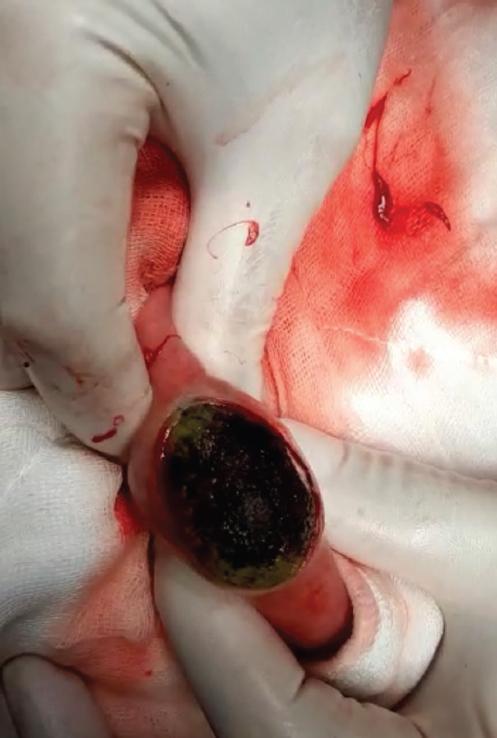Introduction
Cholelithiasis is a common condition in general surgery practice with a frequency of 10-20% in adults1,2. Although most of the patients are asymptomatic, they can also present with biliary colic or complicated gallbladder diseases such as acute cholecystitis, choledocholithiasis, cholangitis, and/or gallstone pancreatitis, gallstone ileus, and even liver abscess3. The treatment of choice for gallbladder stones is laparoscopic cholecystectomy. However, during the coronavirus disease-19 (COVID-19) pandemic process, elective surgeries were postponed with the suggestions of many surgical associations4,5. Postponement of cholecystectomies brought the risk of increased complications of cholelithiasis. Here, we present a patient with cholelithiasis, who had a history of hospitalization with cholecystitis attacks twice during the pandemic process, and who was undergoing an emergent surgical intervention on her third visit for gallstone ileus which is a rare complication of cholelithiasis.
Presentation of case
A 77-year-old diabetic, hypertensive, and asthmatic female patient, first admitted to the emergency room in June 2020 with pain in the right upper quadrant of the abdomen and nausea for 2 days. Acute cholecystitis was diagnosed by the examinations, and percutaneous cholecystostomy was performed for the treatment because of the pandemic process. The patient was hospitalized for 6 days and was discharged with a percutaneous cholecystostomy catheter which was removed after 21 days.
Approximately 2 months later, the patient was admitted to the emergency department with abdominal pain and nausea again. By the examination, acute cholecystitis was diagnosed and the patient was hospitalized for medical treatment for 7 days.
Three months later, following the second hospitalization, the patient presented with complaints of nausea, vomiting, abdominal pain, and distension. Fluid levels were monitored on the abdominal radiograph. Upon the detection of the Rigler's triad (ileus, pneumobilia, and ectopic gallstones) (Figs. 1) on contrasted abdominal computed tomography, she was hospitalized to be operated on with the diagnosis of gallstone ileus. A limited mobile, large mass that completely obstructed the jejunum at a distance of 130 cm from the Treitz ligament was observed in the exploration performed by laparotomy (Fig. 2). The intestinal segment proximal to the mass was dilated due to obstruction. A large gallstone of 3 cm×4 cm was removed by enterotomy. Cholecystectomy and fistula repair were left for a second session. Oral food intake was started on the post-operative 3rd day and she was discharged on the 7th day without any complications.
Discussion
The World Health Organization (WHO) declared COVID-19 as a public health emergency on March 11, 2020. As of December 20, 2020, more than 74,879,038 confirmed cases have been reported worldwide6. Since the COVID-19 outbreak reached pandemic levels, human resources, research, and spending to evolve in this direction in the healthcare system have deteriorated. To respond to millions of pandemic patients, elective surgeries have been stopped or limited. Many international surgical societies recommend avoiding elective surgical procedures. Undoubtedly, this situation has brought along an increased risk of complications of benign diseases such as cholelithiasis.
Gallstone ileus is a rare (0.3-0.5%) complication of cholelithiasis. Recurrent attacks of cholecystitis play a role in the pathogenesis7. In the history of our patient, there was an episode of cholecystitis that occurred twice within 5 months. As a result of chronic inflammation, adhesions occur between the gallbladder and the gastrointestinal tract. Ischemia and erosion develop in the gallbladder wall due to the compression of gallstones8. The process results in a bilioenteric fistula. Bilioenteric fistula most often occurs in the duodenum (60-68%). Cholecystocolic and cholecystogastric fistulas have also been reported9. While small gallstones passing through the fistula tract do not cause any problems, stones larger than 2.5 cm in diameter may cause obstruction. Obstruction is often seen at the distal or terminal ileum level (75%). Gallstone ileus accounts for 1-4% of all cases of mechanical intestinal obstruction, but for up to 25% of those in patients over 65 years. The frequency increases in women and especially over the age of 70 years10,11.
The diagnosis of gallstone ileus is made perioperatively in 50% of patients10. Classical Rigler's triad consisting of pneumobilia, intestinal obstruction, and ectopic gallstones are seen in 40-70% of patients. In our case, the Rigler's triad was detected in the pre-operative evaluations10-12.
The treatment of gallstone ileus is surgical. There are differences of opinion on how to perform the surgical approach. The generally accepted approach is to remove the stone by enterotomy in the first operation and to perform cholecystectomy and biliary-enteric fistula repair in the second operation11,12. In our case, we performed stone extraction by an enterotomy and small bowel repair. We left cholecystectomy and fistula repair for a second operation. Hence, after three hospitalizations and one emergency surgery, the gallbladder is still in place and now a duodenal fistula with even.
Conclusion
Postponing elective surgeries during the COVID-19 pandemic has also increased the risk of complications of benign diseases. In this process, it should not be forgotten that we may encounter cholelithiasis complications, which we rarely see before the pandemic, more frequently, and the issue of postponing elective surgeries should be questioned with more concrete data.











 nueva página del texto (beta)
nueva página del texto (beta)




